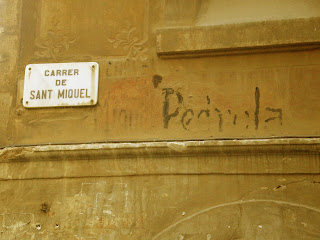
Saturday afternoon found me strolling down the streets of Barceloneta seeking refuge from the wind that looked as if it was destined to strip away the beach of all its sand. It is funny how places close to the sea exposed to strong winds tend to have a similar architecture, with small narrow streets, where one can still find some peace even though a few meters away the palm trees are bending and the waves are roaring. Like many of the Greek islands, Barceloneta is also built in a grid of very narrow streets, packed next to each other, providing shed from the tramontana, while allowing the sea breeze to blow through and cool things off during the hot summer days.
As I walked down from the Plaza de Barceloneta towards the sea I came across this street sign on the corner of Carrer de Sant Miguel and Escuder. An old building stood there, its walls grey and dirty, no tiles or fancy colours, just a patine of what looked to me like the sepia toner of old photos. There, next to the sign reading the name of the street, someone had used black paint and old-style calligraphy to write a name: "Miguel Pedrola". From that point of view, it looked as if this street had two names, two Miguels, one who was a saint and another one about whom I knew nothing. Who was Miguel Pedrola?

As I normally take pride in earning my living as a researcher, I felt it was time for me to prove it. I took a shortcut to the office and started digging into google-land. A first search gave me some hints. Miguel Pedrola's name was listed in some old marxist archives as leader of the POUM youth during the Civil War. Further search in the Civil War archives revealed that the young Pedrola fell in the front of Aragon sometime early 1937. This would mean he had no chance to see his comrades being stigmatized as trotskyist-antirevolutionaries during the incidents of May 1937 in Barcelona. Staying away from this tragically ironic conflict he fought his good fight and fell for what he believed. Therefore, even though not a Saint he might have deserved a street with his name.
Some more of library-digging at home today shed more light into the story of this street with two names. According to the City Hall's registry this street is listed with two names although the official street sign reads only the first, more divine one. The story behind this is that people from the neighborhood of Barceloneta, where Pedrola came from, wanted the name changed but some dispute with the municipal authorities at some distant time prevented that. The street is shown in all maps and guides as Carrer de Sant Miguel and the name of Pedrola is slowly drifting towards oblivion.
The person who painted the sign on the wall, might have never met Pedrola himself. He might have been the son of one of his comrades, a distant cousin who grew up listening stories about him, or the girl Pedrola never married, or her daughter, or a neighbour with whom they would play football on Sundays. In any case it was someone who remembered, someone who would like us to remember also.
So, next time you pass by Carrer Sant Miguel, take a short moment to take a look at the corner dedicated to Miguel Pedrola, a youngster who, being no Saint, died for democracy some sixty years ago, somewhere close to Teruel.
Fascinating find.
ReplyDeleteRegarding Borges thoughts onthis comment I do not know, but for shore Freud would would have some Enlightened words to say reagarding this identity problem you are apparently going through: two names, one street and even sex is envolved, or being Miguel a saint..the lack of it!
ReplyDelete